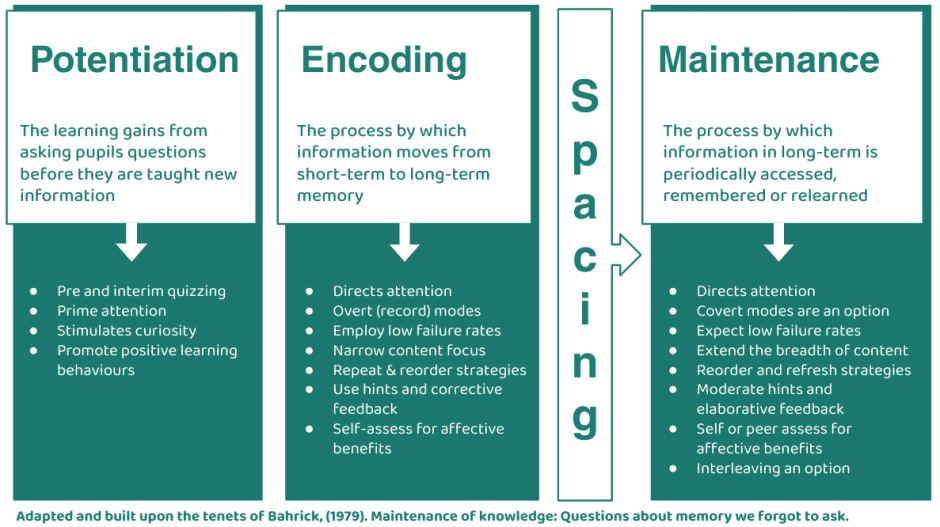Dr Harry Bahrick research and insights continues to gnaw away at me. Widely recognised for his accomplishments as a pioneering researcher and as a teacher, his elucidatory commentary is both accessible and compelling. Back in 1979 he was critical of education, forty years on, do we have more to offer teachers other than “the general advice to practice and rehearse frequently.” If I am honest, I am hoping that “Test-enhanced learning: A practical guide to improving academic outcomes for all students,” offers a little more than that.
What’s eating Mr Still
If we are considering Bahrick’s research, the key point is Bahrick’s proposal that “the maintenance of knowledge is a two-phase process.” So let’s reorder Bahrick’s paper a little, to help explain more clearly, what I am wrestling with. I have taken the last reference (the conclusion) and presented it first, separated the component points, added bold and corresponding terms in square brackets.
Thus, maintenance of knowledge is assumed to reflect a two-phase process:
an acquisition [encoding] phase, during which information is forgotten between successive exposures and periodically reacquired, followed by,
a maintenance phase, during which no reacquisition is required, but (presumably) the information must be accessed or used periodically.
Bahrick (1979: 299)
Learning, remembering, relearning are required to ensure knowledge become semipermanent. Later in the post, I will argue that more recent research adds a third phase – a “potentiated” phase.
Teaching is hard
…much of what is learned during a first exposure is forgotten during the interval between exposures and must be relearned later to become a part of semipermanent knowledge.
(Bahrick 1979: 297)
Due attentional and cognitive load limitations of learners, all with unique prior knowledge with which to perceive and access learning, leaves teaching prone to be far more inefficient than we would hope for. Hence, how much new knowledge is securely encoded let alone transferred to semipermanent storage?
Takeaway: Direct attention. Minimise distraction. Manage cognitive load. Check understanding. Teach new knowledge less. Know that the interval between exposures (a timetabling constraint) is an important variable.
Teach and re-teach. Mesocycles, macro-cycles, across curriculum cycles
Acquisition of semipermanent knowledge typically involves repeated exposure to information, with losses of information during intervals between exposures.
(Bahrick 1979: 296)
I have discussed the concept of teaching meso-cycles here. Teach less. Teach as little as possible to provide thorough coverage of the content. Be precise about what you include and exclude. Plan to re-teach knowledge – both within a lesson and across lessons, units, and academic year cycles. One shot teaching falls well short of learning, (three encounters across three spaced encounters comes closer). Plan to reteach and for pupils to learn and relearn.
Semi permanent learning
Bahrick goes on to describe the “total acquisition process” as:
a cycle of acquisition, loss, and reacquisition of information, with diminishing amounts of information lost during the intervals between exposures until the information becomes part of permanent knowledge retrievable without further relearning.
(Bahrick 1979: 298)
How can teaching be most efficient and most effective? Exploiting the intervals between [in and out of classroom] exposures is one opportunity? Teaching with testing, quizzing, retrieval practice, with widely reported direct and indirect benefits for learning, another. We should always consider the only constant variable – time. Testing should not be preserved for assessment of semipermanent knowledge – even though that is clearly important.
In reflection of Bahrick’s two-phase process, I would argue that the mnemonic benefits and therefore the testing or quizzing mechanics are different, depending on whether knowledge is being encoded or maintained, or indeed – potentiated.
Potentiated learning
Where there is sufficient prior knowledge, or we can service sufficient information, or preferable pose thought-provoking questions that spark curiosity, potentiated testing, quizzing or retrieval, can be particularly effective. And there are further positive twists too. Both pre-testing and interim testing have a retrieval-specific effect. They potentiate learning of the, as yet, untaught knowledge. They can stimulate curiosity and positive learning behaviors such as ‘answer seeking behaviours.’ What is more, students exert effort towards encoding that new knowledge and more effort to retrieve [and maintain] the subsequently studied information.
Therefore the next two questions are simple, what does this look like in the classroom? How do we leverage these gains for all pupils?



